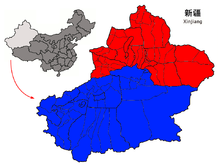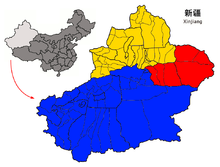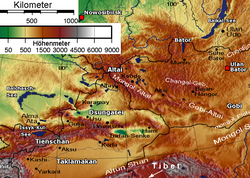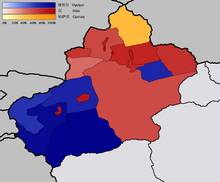Talk:History of the administrative divisions of China before 1912
| This article was nominated for deletion on 31 March 2023. The result of the discussion was redirect. |
Praise
[edit]The tables are very nicely done! --Menchi 21:34, 28 Nov 2004 (UTC)
Yes, excellent, much appreciated. --WestNab (talk) 16:24, 3 February 2013 (UTC)
Zhou: province vs. region
[edit]i'm at a loss whether zhou should be translated as "province" or "region". Personally i prefer the latter as it is easily distinguishable from the modern provinces. However i do not know if the convention or common practice had always been "province". Please advise? --Plastictv 05:42, 26 Jun 2005 (UTC)
- ... Um, I have no idea actually. Do you know what the prevalent convention is in Sinologist literature? -- ran (talk) 00:01, Jun 27, 2005 (UTC)
- Exactly my question. --Plastictv 02:42, 27 Jun 2005 (UTC)
- Me too. Yug2 (talk) 16:57, 29 May 2008 (UTC)
- Exactly my question. --Plastictv 02:42, 27 Jun 2005 (UTC)
- What's the confusion? It should be 'province'. 'Regions' are less formal general areas. Amusingly, that's an accurate description for the Nine Provinces (where the standard translation keeps you from using it), but by the Han they're definitely provinces instead.
- Now, the modern version of 州 is 'prefecture' and that could work, but (a) it's nonstandard WP:OR, (b) it puts emphasis on the military commander, and (c) you'd run into problems with 府, the provincial subdivision that gets the standard translation "prefecture". — LlywelynII 07:10, 16 August 2011 (UTC)
ROC claim to HK/MO
[edit]This article, like the government in Taiwan, completely ignores any Republic of China claim to Hong Kong and Macau. It is a difficult thing to source and make sense of if anyone wants to try. SchmuckyTheCat 23:20, 17 April 2007 (UTC)
- It's difficult to make sense of your statement. What do you mean? (HK and Macao aren't standard divisions; they're historically part of 广东.) — LlywelynII 07:10, 16 August 2011 (UTC)
Recent small expansion
[edit]I just added :
- one carte for Sui divisions (Image:China, 610.svg) - according to the Cambridge history of China vol.3
- one carte for Tang divisions (Image:China, 742.svg) - according to the Cambridge history of China vol.3
- I also expanded the section Sui dynasty, since we now have a map for this time.
NB: the section SUI dynasty is to complete. Especially the table, to :
- localize the Sui zhou compare to current (2008) province. This is vissible when you enlarge the map.
- find the capitals of the Sui's Zhou... I have a scan in Chinese that I can't read, send me your email, I send you the scan. Yug (talk) 17:03, 29 May 2008 (UTC)
moved table
[edit]I moved this table and replaced with another for the sake of clarity--Gurdjieff (talk) 15:25, 11 February 2010 (UTC)
| Chinese | English translation | Level | Syllables[1] | Created | Abolished | ||
|---|---|---|---|---|---|---|---|
| T | S | pinyin | |||||
| 郡 | 郡 | jùn | Commandery | before 106 BC: 1st after 106 BC: 2nd |
usually 1 or 2 | Warring States Period | Tang Dynasty |
| 縣 | 县 | xiàn | ancient: prefecture or district modern: county |
ancient: lowest modern: 3rd |
usually 1 or 2 | Spring and Autumn Period | still exist |
| 州 | 州 | zhōu | before 627: province after 627: prefecture |
before 627: 1st after 627: 2nd to 3rd |
usually 1, sometimes 2 | 106 BC | 1913 |
| 道 | 道 | dào[2] | circuit | From 627 to Yuan Dynasty: 1st after Yuan Dynasty: 2nd |
usually 2 or 3, never 1 | 627 | 1928[3] |
| 省 | 省 | shěng | province | 1st | usually 2, never 1 | Yuan Dynasty | still exist |
| 市 | 市 | shì | 1st level: municipality 2nd level: prefecture-level city 3rd level: county-level city |
1st to 3rd | usually 2, never 1 | Republic of China | still exist |
- ^ Syllables play an important role in Chinese grammar. Most of the above administrative divisions can only be given names of a certain number of syllables.
- ^ Circuits were renamed 路 (pinyin: lù) during the Song Dynasty.
- ^ In 1928, the Republic of China replaced all circuits with committees or just completely abandoned them.
Former autonomous territory
[edit]What autonomous regions, prefectures and counties were in China? When I get information about them?--Kaiyr (talk) 08:50, 25 June 2011 (UTC)
- When? Autonomous regions are mostly a PRC thing, and they're mostly still around. — LlywelynII 07:10, 16 August 2011 (UTC)
Early Provinces
[edit]Article needs an expanded treatment of the Nine Provinces (see also zh:九州) and also eventually needs to include the actual Qin and Han provinces (see zh:秦朝行政区划 and zh:东汉行政区划) rather than just saying there were 36 or 13 of them. Any bilingual editors have some free time? =) — LlywelynII 07:10, 16 August 2011 (UTC)
- Found the Han territories hidden in the Jin section and tried to clarify the point. Lots of missing stuff still, or half-correct points. The "Government and Administration" sections of the dynasty descriptions of this website seem excellent, although they would need sourcing. — LlywelynII 12:42, 16 August 2011 (UTC)
Image of the Jiuzhou
[edit]I may have been the one that added it, but th image of the 9 provinces I just removed shouldn't be used. It's pretty but seems to have been just arbitrarily done. That is, even for such vague concepts, it's completely misleading as to the even notional idea of where these provinces were. Liang was understood to include the upper Wei and W Han rivers but here it omits both. — LlywelynII 13:33, 23 December 2013 (UTC)
Split
[edit]Since history have seen uncountable province changes, it will be better to provide just one exemple by dynasty here. If more data is available, then split into separate articles. For the PRC, simply display the current situation, while past PRC organizations may be display in an other specific History of the administrative divisions of PRC (1949-today) Yug (talk) 19:37, 27 March 2012 (UTC)
This seems to be a sensible plan. WestNab (talk) 16:29, 3 February 2013 (UTC)
Qing Governors and Their Provinces: The Evolution of Territorial Administration in China, 1644-1796 By R. Kent Guy
[edit]- Guy, R. Kent (2010). Qing Governors and Their Provinces: The Evolution of Territorial Administration in China, 1644-1796 (illustrated ed.). University of Washington Press. ISBN 978-0295990194. Retrieved 10 March 2014.
Rajmaan (talk) 21:16, 25 December 2012 (UTC)
List of governors, mayors, administrators etc. of Chinese provinces and other administrative units from Qing times to today
[edit]http://www.worldstatesmen.org/China_prov.html
Rajmaan (talk) 19:20, 9 May 2014 (UTC)
List of governors, mayors, administrators etc. of Chinese provinces and other administrative units from Qing times to today
[edit]http://www.worldstatesmen.org/China_prov.html
Rajmaan (talk) 19:20, 9 May 2014 (UTC)
Qing administration of Xinjiang (pre 1884)
[edit]Ili (ele) aka Dzungharia was not considered a part of "turkestan"(tarim basin) during early Qing times. the tarim basin and ili were governed separately.
Put the information into wikisource and then link to this article
http://books.google.com/books?id=SV9AAAAAYAAJ&pg=PA21#v=onepage&q&f=false
http://books.google.com/books?id=ik4BAAAAQAAJ&pg=PA554#v=onepage&q&f=false
http://books.google.com/books?id=KGlJAAAAYAAJ&pg=PA681#v=onepage&q&f=false
Rajmaan (talk) 04:26, 4 February 2013 (UTC)
Dzungharia or Ili was called Zhunbu 準部 (Dzungar region) Tianshan Beilu 天山北路 (Northern March), or "Xinjiang" 新疆 (New Frontier). It was formerely the area of the Zunghar Khanate 準噶爾汗國, the land of the Dzungar people
http://books.google.com/books?id=MC6sAAAAIAAJ&pg=PA21#v=onepage&q&f=false
While the Tarim Basin was known as "Tianshan Nanlu 天山南路 (southern March), Huibu 回部 (Muslim region), Huijiang 回疆 (Muslim frontier), Chinese Turkestan, Kashgaria, Little Bukharia, East Turkestan", and the traditional Uyghur name for it was Altishahr (Uyghur: التى شهر, romanized: Altishahr). It was formerly the area of the Eastern Chagatai Khanate 東察合台汗國, land of the Uyghur people before being conquered by the Dzungars.
http://books.google.com/books?id=MC6sAAAAIAAJ&pg=PA23#v=onepage&q&f=false
La Kalmouquie (Kalmykia), La Petite Bucharie (Little Bukharia) http://books.google.com/books?id=CghUAAAAQAAJ&pg=PA144#v=onepage&q&f=false
Jungharian steppe plateau and the Tarim Basin were separated by the Tianshan mountains.
http://books.google.com/books?id=KTmO416hNQ8C&pg=PA1#v=onepage&q&f=false
creation of Xinjiang province
http://books.google.com/books?id=KTmO416hNQ8C&pg=PA5#v=onepage&q&f=false
- Christian Tyler (2004). Wild West China: The Taming of Xinjiang. Rutgers University Press. p. 56. ISBN 978-0813535333.
- Inner Asia, Volume 4, Issues 1-2. Contributor University of Cambridge. Mongolia & Inner Asia Studies Unit. The White Horse Press for the Mongolia and Inner Asia Studies Unit at the University of Cambridge. 2002. p. 127. ISBN 0804729336. Retrieved 10 March 2014.
{{cite book}}: CS1 maint: others (link)
Dzungaria Zhunbu 準部 (Dzungar region)Tianshan Beilu 天山北路 (Northern March)
- Millward, James A. (1998). Beyond the Pass: Economy, Ethnicity, and Empire in Qing Central Asia, 1759-1864 (illustrated ed.). Stanford University Press. p. 21. ISBN 0804729336. Retrieved 10 March 2014.
- Millward, James A. (2007). Eurasian Crossroads: A History of Xinjiang (illustrated ed.). Columbia University Press. p. 97. ISBN 978-0231139243. Retrieved 10 March 2014.
- Kim, Hodong (2004). Holy War in China: The Muslim Rebellion and State in Chinese Central Asia, 1864-1877 (illustrated ed.). Stanford University Press. p. 218. ISBN 0804767238. Retrieved 10 March 2014.
- Kim, Hodong (2004). Holy War in China: The Muslim Rebellion and State in Chinese Central Asia, 1864-1877 (illustrated ed.). Stanford University Press. p. 15. ISBN 0804767238. Retrieved 10 March 2014.
Tarim Basin Huijiang ("Muslim-land") "Tianshan Nanlu 天山南路 (southern March)
- Millward, James A. (1998). Beyond the Pass: Economy, Ethnicity, and Empire in Qing Central Asia, 1759-1864 (illustrated ed.). Stanford University Press. p. 23. ISBN 0804729336. Retrieved 10 March 2014.
Tianshan Donglu 天山東路 (Eastern March)
http://books.google.com/books?id=MC6sAAAAIAAJ&pg=PA24#v=onepage&q&f=false
http://books.google.com/books?id=MC6sAAAAIAAJ&pg=PA126#v=onepage&q&f=false
Maps of Qing Xinjiang
| Maps of Qing Xinjiang |
|---|
| The following discussion has been closed. Please do not modify it. |
|
          Uyghur majority Han majority Kazakh majority  http://www.zwbk.org/MyLemmaShow.aspx?lid=80243 http://www.zwbk.org/Lemma_PictureShow.aspx?pid=20101011082329454_980.jpg&title=明朝疆域形势图&lid=80243 |
Rajmaan (talk) 04:33, 25 June 2014 (UTC)
List of the Higher Metropolitan and Provincial Authorities of China (with Genealogical Table of the Imperial Family) By Great Britain. Legation (China)
[edit]Rajmaan (talk) 04:16, 2 September 2014 (UTC)
Ethnic composition of Qing provincial governors and other official positions
[edit]http://books.google.com/books?id=0kcMAAAAYAAJ&pg=PA128#v=onepage&q&f=false
http://books.google.com/books?id=0kcMAAAAYAAJ&pg=PA125#v=onepage&q&f=false
Rajmaan (talk) 04:54, 2 September 2014 (UTC)
Missing many Song circuits
[edit]I've been doing a cursory look through a few books like Dictionary of the Ben Cao Gang Mu and it seems like this list is missing quite a few that this one lists. For instance it doesn't have the Chuan lu or Xia lu mentioned on the page for Sichuan#Names.--Prisencolin (talk) 21:03, 13 April 2020 (UTC)
A Commons file used on this page or its Wikidata item has been nominated for deletion
[edit]The following Wikimedia Commons file used on this page or its Wikidata item has been nominated for deletion:
Participate in the deletion discussion at the nomination page. —Community Tech bot (talk) 21:09, 14 April 2020 (UTC)
A Commons file used on this page or its Wikidata item has been nominated for deletion
[edit]The following Wikimedia Commons file used on this page or its Wikidata item has been nominated for deletion:
Participate in the deletion discussion at the nomination page. —Community Tech bot (talk) 21:53, 14 April 2020 (UTC)
Proposed merge
[edit]The subject matter of this page and Administration of territory in dynastic China appear nearly identical. In fact, many of the sections appear similar. The main difference seems to be that that article is much better written/sourced than this one. I'd appreciate other editors' thoughts. SilverStar54 (talk) 23:39, 23 March 2023 (UTC)
- Unsure. Although the other article is better sourced, the subjects are not entirely the same at least judging by the title. This one could be improved to cover the changes in administrative divisions, their borders, and names. The other article also doesn't cover why the administrative divisions changed and the historical events that caused them. It's much more focused on the functions and hierarchy rather than historical events. Also considering how woefully undercited this article is, if we were to keep the same standard of quality as the other article, there would be hardly anything to merge at all. Qiushufang (talk) 23:51, 23 March 2023 (UTC)
- @Qiushufang I see what you mean about the other article being a bit short on discussion of the historical events that led administrative divisions to change over time.
- Do you think a merge would be appropriate if more information were added to the other article about why administrative divisions changed over time? To me, it doesn't make a lot of sense to separate the "why" and "how" of historical changes from details on what the system was in each dynasty. SilverStar54 (talk) 19:44, 31 March 2023 (UTC)
- The immediate problem is that this article contains little to no sourced info, so there is nothing to "merge". It would just be a deletion. Ideally it would have had sourced info on the change of territory in history. Then such a merge would have been meaningful. Qiushufang (talk) 21:14, 31 March 2023 (UTC)
- Okay got it. I'll propose deletion, then. SilverStar54 (talk) 23:00, 31 March 2023 (UTC)
- The immediate problem is that this article contains little to no sourced info, so there is nothing to "merge". It would just be a deletion. Ideally it would have had sourced info on the change of territory in history. Then such a merge would have been meaningful. Qiushufang (talk) 21:14, 31 March 2023 (UTC)
